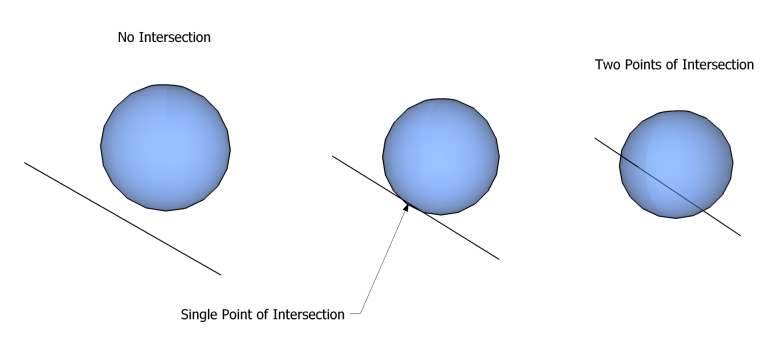Line–sphere Intersection on:
[Wikipedia]
[Google]
[Amazon]
 In
In
 In
In analytic geometry
In mathematics, analytic geometry, also known as coordinate geometry or Cartesian geometry, is the study of geometry using a coordinate system. This contrasts with synthetic geometry.
Analytic geometry is used in physics and engineering, and als ...
, a line and a sphere
A sphere (from Ancient Greek, Greek , ) is a surface (mathematics), surface analogous to the circle, a curve. In solid geometry, a sphere is the Locus (mathematics), set of points that are all at the same distance from a given point in three ...
can intersect in three ways:
# No intersection at all
# Intersection in exactly one point
# Intersection in two points.
Methods for distinguishing these cases, and determining the coordinates
In geometry, a coordinate system is a system that uses one or more numbers, or coordinates, to uniquely determine and standardize the Position (geometry), position of the Point (geometry), points or other geometric elements on a manifold such as ...
for the points in the latter cases, are useful in a number of circumstances. For example, it is a common calculation to perform during ray tracing.
Calculation using vectors in 3D
Invector notation
In mathematics and physics, vector notation is a commonly used notation for representing vectors, which may be Euclidean vectors, or more generally, members of a vector space.
For denoting a vector, the common typographic convention is lower ...
, the equations are as follows:
Equation for a sphere
A sphere (from Ancient Greek, Greek , ) is a surface (mathematics), surface analogous to the circle, a curve. In solid geometry, a sphere is the Locus (mathematics), set of points that are all at the same distance from a given point in three ...
:
:* : points on the sphere
:* : center point
:* : radius of the sphere
Equation for a line starting at
:
:* : points on the line
:* : origin of the line
:* : distance from the origin of the line
:* : direction of line (a non-zero vector)
Searching for points that are on the line and on the sphere means combining the equations and solving for , involving the dot product
In mathematics, the dot product or scalar productThe term ''scalar product'' means literally "product with a Scalar (mathematics), scalar as a result". It is also used for other symmetric bilinear forms, for example in a pseudo-Euclidean space. N ...
of vectors:
:Equations combined
::
:Expanded and rearranged:
::
:The form of a quadratic formula
In elementary algebra, the quadratic formula is a closed-form expression describing the solutions of a quadratic equation. Other ways of solving quadratic equations, such as completing the square, yield the same solutions.
Given a general quadr ...
is now observable. (This quadratic equation is an instance of Joachimsthal's equation.)
::
:where
:*
:*